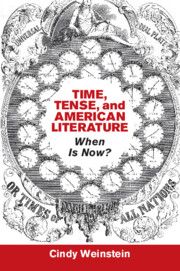Book contents
- Time, Tense, and American Literature
- Cambridge Studies in American Literature and Culture
- Time, Tense, and American Literature
- Copyright page
- Dedication
- Contents
- Book part
- Introduction Tempo(e)rality
- Chapter 1 Edgar Huntly’s first time
- Chapter 2 When is now? Poe’s Pym
- Chapter 3 Heaven’s tense: Narration in The Gates Ajar
- Chapter 4 Now and then: Time in An American Tragedy
- Chapter 5 The “would” to power: Edward P. Jones’s The Known World
- Before and afterword: Making connexions
- Notes
- Bibliography
- Index
- References
Bibliography
Published online by Cambridge University Press: 05 September 2015
- Time, Tense, and American Literature
- Cambridge Studies in American Literature and Culture
- Time, Tense, and American Literature
- Copyright page
- Dedication
- Contents
- Book part
- Introduction Tempo(e)rality
- Chapter 1 Edgar Huntly’s first time
- Chapter 2 When is now? Poe’s Pym
- Chapter 3 Heaven’s tense: Narration in The Gates Ajar
- Chapter 4 Now and then: Time in An American Tragedy
- Chapter 5 The “would” to power: Edward P. Jones’s The Known World
- Before and afterword: Making connexions
- Notes
- Bibliography
- Index
- References
- Type
- Chapter
- Information
- Time, Tense, and American LiteratureWhen Is Now?, pp. 165 - 174Publisher: Cambridge University PressPrint publication year: 2015
References
- 1
- Cited by



